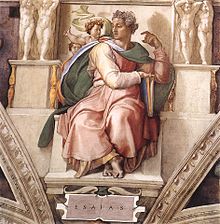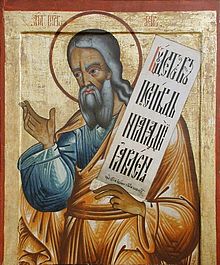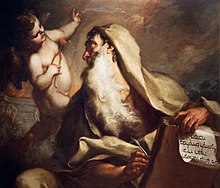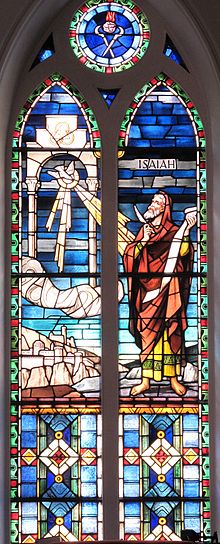This is an old revision of this page, as edited by יניב הורון (talk | contribs) at 14:54, 28 February 2018 (WP:ERA). The present address (URL) is a permanent link to this revision, which may differ significantly from the current revision.
Revision as of 14:54, 28 February 2018 by יניב הורון (talk | contribs) (WP:ERA)(diff) ← Previous revision | Latest revision (diff) | Newer revision → (diff) This article is about the prophet. For other uses, see Isaiah (disambiguation). "Isaias" and "Esaias" redirect here. For the given name, see Isaias (given name).| Isaiah | |
|---|---|
 Fresco from the Sistine Chapel ceiling by Michelangelo Fresco from the Sistine Chapel ceiling by Michelangelo | |
| Prophet | |
| Born | 8th century BC Judah (?) |
| Died | 7th century BC |
| Venerated in | Judaism Christianity Islam |
| Feast | May 9 |
Isaiah was the 8th-century BC Jewish prophet for whom the Book of Isaiah is named.
Within the text of the Book of Isaiah, Isaiah himself is referred to as "the prophet", but the exact relationship between the Book of Isaiah and any such historical Isaiah is complicated. The traditional view is that all 66 chapters of the book of Isaiah were written by one man, Isaiah, possibly in two periods between 740 BCE and c. 686 BCE, separated by approximately 15 years, and includes dramatic prophetic declarations of Cyrus the Great in the Bible, acting to restore the nation of Israel from Babylonian captivity. Another widely-held view is that parts of the first half of the book (chapters 1–39) originated with the historical prophet, interspersed with prose commentaries written in the time of King Josiah a hundred years later, and that the remainder of the book dates from immediately before and immediately after the end of the exile in Babylon, almost two centuries after the time of the historic prophet.
Jews and Christians consider the Book of Isaiah a part of their Biblical canon; he is the first listed (although not the earliest) of the Nevi'im Aharonim, the latter prophets. Muslims consider Isaiah a prophet mentioned in Muslim exegesis of canonical scriptures.
Alternative spellings include (US: /aɪˈzeɪ.ə/ or UK: /aɪˈzaɪ.ə/; Hebrew: יְשַׁעְיָהוּ, Modern: Yešayahu, Tiberian: Yəšạʻyā́hû; Template:Lang-syr ˀēšaˁyā; Greek: Ἠσαΐας, Ēsaïās; Latin: Isaias; Arabic: إشعيا Ašaʿyāʾ or šaʿyā; "Yah is salvation"
Biography


The first verse of the Book of Isaiah states that Isaiah prophesied during the reigns of Uzziah (or Azariah), Jotham, Ahaz, and Hezekiah, the kings of Judah (Isaiah 1:1). Uzziah's reign was 52 years in the middle of the 8th century BCE, and Isaiah must have begun his ministry a few years before Uzziah's death, probably in the 740s BCE. Isaiah lived until the fourteenth year of Hezekiah's reign (who died 698 BCE). He may have been contemporary for some years with Manasseh. Thus Isaiah may have prophesied for as long as 64 years.
According to some modern interpretations, Isaiah's wife was called "the prophetess" (Isaiah 8:3), either because she was endowed with the prophetic gift, like Deborah (Judges 4:4) and Huldah (2 Kings 22:14–20), or simply because she was the "wife of the prophet". They had two sons, naming one Shear-jashub, meaning "A remnant shall return" (Isaiah 7:3), and the younger, Maher-Shalal-Hash-Baz, meaning, "Spoil quickly, plunder speedily" (Isaiah 8:3).

Soon after this, Shalmaneser V determined to subdue the kingdom of Israel, taking over and destroying Samaria (722 BCE). So long as Ahaz reigned, the kingdom of Judah was unmolested by the Assyrian power. But when Hezekiah gained the throne, he was encouraged to rebel "against the king of Assyria" (2 Kings 18:7), and entered into an alliance with the king of Egypt (Isaiah 30:2–4). The king of Assyria threatened the king of Judah, and at length invaded the land. Sennacherib (701 BC) led a powerful army into Judah. Hezekiah was reduced to despair, and submitted to the Assyrians (2 Kings 18:14–16). But after a brief interval, war broke out again. Again Sennacherib led an army into Judah, one detachment of which threatened Jerusalem (Isaiah 36:2–22; 37:8). Isaiah on that occasion encouraged Hezekiah to resist the Assyrians (37:1–7), whereupon Sennacherib sent a threatening letter to Hezekiah, which he "spread before the LORD" (37:14).
Then Isaiah the son of Amoz sent unto Hezekiah, saying: "Thus saith the LORD, the God of Israel: Whereas thou hast prayed to Me against Sennacherib king of Assyria,
this is the word which the LORD hath spoken concerning him: The virgin daughter of Zion hath despised thee and laughed thee to scorn; the daughter of Jerusalem hath shaken her head at thee.
Whom hast thou taunted and blasphemed? And against whom hast thou exalted thy voice? Yea, thou hast lifted up thine eyes on high, even against the Holy One of Israel!" (37:21–23)
According to the account in 2 Kings 19 (and its derivative account in 2 Chronicles 32) an angel of God fell on the Assyrian army and 185,000 of its men were killed in one night. "Like Xerxes in Greece, Sennacherib never recovered from the shock of the disaster in Judah. He made no more expeditions against either the Southern Levant or Egypt."
The remaining years of Hezekiah's reign were peaceful (2 Chr 32:23–29). Isaiah probably lived to its close, and possibly into the reign of Manasseh. The time and manner of his death are not specified in either the Bible or other primary sources. The Talmud says that he suffered martyrdom by being sawn in two under the orders of Manasseh. According to rabbinic literature, Isaiah was the maternal grandfather of Manasseh.
Some writers assert that Isaiah was a vegetarian, on the basis of passages in the Book of Isaiah that extol nonviolence and reverence for life, such as Isaiah 1:11, 11:6-9, 65:25, and 66:3. Some of these writers refer to "the vegetarian Isaiah", "the notorious vegetarian Isaiah", and "Isaiah, the vegetarian prophet".
The book of Isaiah, along with the book of Jeremiah, is distinctive in the Hebrew bible for its direct portrayal of the "wrath of the Lord" as presented, for example, in Isaiah 9:19 stating, "Through the wrath of the Lord of hosts is the land darkened, and the people shall be as the fuel of the fire."
In Christianity

The Ascension of Isaiah, a pseudegraphical Christian text dated to sometime between the end of the 1st Century to the beginning of the 3rd, gives a detailed story of Isaiah confronting an evil false prophet and ending with Isaiah being martyred - none of which is attested in the original Biblical account.
Gregory of Nyssa (c. 335–395), believed that the Prophet Isaiah "knew more perfectly than all others the mystery of the religion of the Gospel". Jerome (c. 342–420) also lauds the Prophet Isaiah, saying, "He was more of an Evangelist than a Prophet, because he described all of the Mysteries of the Church of Christ so vividly that you would assume he was not prophesying about the future, but rather was composing a history of past events." Of specific note are the songs of the Suffering Servant, which Christians say are a direct prophetic revelation of the nature, purpose, and detail of the death of Jesus Christ.
The Book of Isaiah is quoted many times by New Testament writers. Ten of those references are about the Suffering Servant, how he will suffer and die to save many from their sins, be buried in a rich man's tomb, and be a light to the Gentiles. The Gospel of John says that Isaiah "saw Jesus’ glory and spoke about him."
Latter-day Saints
Isaiah is also a prominent prophet in the Latter-day Saint theology. Mormons consider the starting of The Church of Jesus Christ of Latter-day Saints to be a fulfillment of Isaiah 11, the translation of the Book of Mormon to be a fulfillment of Isaiah 29, and the building of LDS temples as a fulfillment of Isaiah 2:2. In addition, the Book of Mormon and Doctrine and Covenants quote Isaiah more than any other prophet. The Book of Mormon quotes Jesus Christ as stating that "great are the words of Isaiah", and that all things prophesied by Isaiah either have been or will be fulfilled.
In Islam
Although Isaiah is not mentioned by name in the Quran or the Hadith, Muslim sources have accepted him as a prophet. Some Muslim scholars, such as Ibn Kathir and Kisa'i, reproduced Jewish traditions regarding Isaiah, which were transmitted through early Jewish converts to Islam. Isaiah is mentioned as a prophet in Ibn Kathir's Story of Prophet Isaiah, and the modern writers Muhammad Asad and Abdullah Yusuf Ali accepted Isaiah as a true Hebrew prophet, who preached to the Israelites following the death of King David. Isaiah is well known in Muslim exegesis and literature, notably for his predictions of the coming of Jesus and Muhammad. Isaiah's narrative in Muslim literature can be divided into three sections. The first establishes Isaiah as a prophet of Israel during the reign of Hezekiah; the second relates Isaiah's actions during the siege of Jerusalem by Sennacherib; and the third warns the nation of coming doom.
Muslim exegesis preserves a tradition parallel to the Hebrew Bible, which states that Hezekiah was king in Jerusalem during Isaiah's time. Hezekiah heard and obeyed Isaiah's advice, but could not quell the turbulence in Israel. This tradition maintains that Hezekiah was a righteous man and that the turbulence worsened after him. After the death of the king, Isaiah told the people not to forsake God, and he warned Israel to cease from its persistent sin and disobedience. Muslim tradition maintains that the unrighteous of Israel in their anger sought to kill Isaiah. In a death that resembles that attributed to Isaiah in Lives of the Prophets, Muslim exegesis recounts that Isaiah was martyred by Israelites by being sawn in two.
Rabbinic literature
Main article: Isaiah in rabbinic literatureAccording to the rabbinic literature, Isaiah was a descendant of the royal house of Judah and Tamar (Sotah 10b). He was the son of Amoz (not to be confused with Prophet Amos), who was the brother of King Amaziah of Judah. (Talmud tractate Megillah 15a).
Notes
- See the article Book of Isaiah for an extended overview of theories of its composition.
References
- Historical Dictionary of Prophets in Islam and Judaism, B. M. Wheeler, Appendix II
- St. John the Baptist Byzantine Catholic Cathedral, Holy Prophet Isaiah
- The Scofield Study Bible III, NKJV, Oxford University Press
- De Jong, Matthijs J., Isaiah Among The Ancient Near Eastern Prophets: A Comparative Study of the Earliest Stages of the Isaiah Tradition and the Neo-Assyrian Prophecies, BRILL, 2007, p. 13–17
- Isaiah 38:1
- JPS Hebrew English Tanakh, Jewish Publication Society, 2000
- ^ Stories of the Prophets, Ibn Kathir, Isaiah bin Amoz
- Wells, John C. (1990). ""Isaiah"". Longman pronunciation dictionary. Harlow, England: Longman. p. 378. ISBN 0-582-05383-8.
- Rippin, A., “S̲h̲aʿyā”, in: Encyclopaedia of Islam, Second Edition, Edited by: P. Bearman, Th. Bianquis, C.E. Bosworth, E. van Donzel, W.P. Heinrichs.
- New Bible Dictionary, Second Edition, Tyndale Press, Wheaton, IL, USA 1987.
- ^
 One or more of the preceding sentences incorporates text from a publication now in the public domain: Easton, Matthew George (1897). "Isaiah". Easton's Bible Dictionary (New and revised ed.). T. Nelson and Sons.
One or more of the preceding sentences incorporates text from a publication now in the public domain: Easton, Matthew George (1897). "Isaiah". Easton's Bible Dictionary (New and revised ed.). T. Nelson and Sons.
- Coogan, Michael D. A Brief Introduction to the Old Testament, Oxford University Press, 2009, p.273.
- Sayce, Archibald Henry. The Ancient Empires of the East. Macmillan, 1884, p. 134.
- "Isaiah", Jewish Encyclopedia
- "HEZEKIAH". JewishEncyclopedia.com.
- "Religious Quotes". Animal Liberation Front. Retrieved 2016-04-01.
- "The Biblical Basis of Veganism". Cincinnati, Ohio: The Nazarenes of Mount Carmel. Retrieved 2016-04-01.
- Braunstein, Mark (1980). "Vegetarianism in Art". Vegetarian Times (40).
Isaiah, the vegetarian prophet, meant also that humans must sit with the lamb, the kid, the ox—because humans must make peace with the animals before they can make peace with other humans.
- Isaiah 9:19.
- The Lives of the Holy Prophets, Holy Apostles Convent, ISBN 0-944359-12-4, page 101.
- Graham, Ron. "Isaiah in the New Testament - Quotations Chart - In Isaiah Order".
- John 12:41
- "Encyclopedia of Mormonism, "Isaiah"".
{{cite web}}: Cite has empty unknown parameter:|dead-url=(help) - "lds.org - Temples".
{{cite web}}: Cite has empty unknown parameter:|dead-url=(help) - "lds.org - Isaiah".
{{cite web}}: Cite has empty unknown parameter:|dead-url=(help) - "3 Nephi 23:1-3".
{{cite web}}: Cite has empty unknown parameter:|dead-url=(help) - Encyclopedia of Islam
- "Ibn Kathir: Story of Prophet Isaiah (pbuh)". islamawareness.net.
- The Holy Qur'an: Text, Translation and Commentary, Note. 2173 to 17:4: "The Book is the revelation given to the Children of Israel. Here it seems to refer to the burning words of Prophets like Isaiah. For example, see Isaiah, chap, 24. or Isaiah 5:20–30, or Isaiah 3:16–26."
- Encyclopedia of Islam, Shaya, Online Web.
- Tabari, History of the Prophets and Kings, i, 638–45
- Isaiah 38.
- "ISAIAH - JewishEncyclopedia.com". jewishencyclopedia.com.
Further reading
- Baltzer, Klaus (2001). Deutero-Isaiah: A Commentary on Isaiah 40–55. Minneapolis: Fortress Press.
- Childs, Brevard S. (2001). Isaiah: a commentary. Louisville, Kentucky: Westminster John Knox Press. ISBN 978-0-664-22143-0.
- Church, Brooke Peters (1953). The Private Lives of the Prophets and the Times in Which They Lived. New York: Rinehart.
- Cohon, Beryl D. (1939). The Prophets: Their Personalities and Teachings. New York: Scribner.
- Herbert, Arthur Sumner (1975). The book of the prophet Isaiah: Commentary. Cambridge: Cambridge University Press. ISBN 0-521-08624-8.
- Herbert, Arthur Sumner (1975). The book of the Prophet Isaiah, chapters 40–66. Cambridge: Cambridge University Press. ISBN 0-521-20721-5.
- Kraeling, Emil G. (1969). The Prophets. Chicago: Rand McNally.
- Miscall, Peter D. (1993). Isaiah. Sheffield, England: JSOT Press. ISBN 1-85075-435-7.
- Quinn-Miscall, Peter D. (2001). Reading Isaiah: poetry and vision. Louisville: Westminster Press. ISBN 0-664-22369-9.
- Phillips, J. B. (1963). Four Prophets, Amos, Hosea, First Isaiah, Micha: A Modern Translation from the Hebrew. New York: Macmillan.
- Sawyer, John F. A. (1996). The fifth gospel: Isaiah in the history of Christianity. Cambridge: Cambridge University Press. ISBN 0-521-44007-6.
- Scott, R. B. Y. (1968). The Relevance of the Prophets. Macmillan: London.
- Smith, J. M. Powis (1941). The Prophets and Their Times. Chicago: University of Chicago.
External links
- Sermons on Isaiah
- Isaiah (Isaias) at the Catholic Encyclopedia
- Avraham Gileadi's new translation and commentary on Isaiah. From a LDS Church perspective.
- Isaiah Testifies of Christ A LDS Church perspective on Isaiah's writings by Gregorio Billikopf.
- Prophet Isaiah Orthodox icon and synaxarion
- Isaiah Commentary
- Isaiah the Prophet at the Christian Iconography web site
| Prophets in the Hebrew Bible / Old Testament | |
|---|---|
| Pre-Patriarchal | |
| Patriarchs / Matriarchs | |
| Israelite prophets in the Torah | |
| Mentioned in the Former Prophets | |
| Major | |
| Minor | |
| Noahide | |
| Other | |
| |
| Extra-Quranic prophets of Islam | |
|---|---|
| In Stories of the Prophets | |
| In Islamic tradition | |
| In Quranic exegesis | |
| Italics = While the figure has been revered by many Muslims as a saint, status as a prophet is not accepted by all. | |